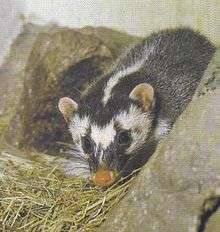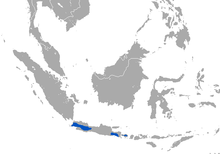Javan ferret-badger
| Javan ferret-badger | |
|---|---|
 | |
| Scientific classification | |
| Kingdom: | Animalia |
| Phylum: | Chordata |
| Class: | Mammalia |
| Order: | Carnivora |
| Family: | Mustelidae |
| Genus: | Melogale |
| Species: | M. orientalis |
| Binomial name | |
| Melogale orientalis Blanford, 1888 | |
 | |
| Javan ferret-badger range | |
| Synonyms | |
|
Melogale personata ssp. orientalis Blanford, 1888 | |
The Javan ferret-badger (Melogale orientalis) is a mustelid endemic to Java and Bali, Indonesia.[2] It is listed as Least Concern on the IUCN Red List and occurs from at least 260 to 2,230 m (850 to 7,320 ft) elevation in or close to forested areas.[1]
Description
An adult Javan ferret-badger weighs between 1 and 2 kg (2.2 and 4.4 lb) with a body length of 35 to 40 cm (14 to 16 in) and a tail of 14.5 to 17 cm (6 to 7 in). The head is small with a narrow, blunt snout, long whiskers and large eyes. The body is low-slung with brown silky fur tinged with red and in some lights looks tawny or greyish. The back of the head and throat are darker brown and there are white markings on the face, neck, throat, chest and abdomen.[3]
Distribution and habitat
The Javan ferret-badger is endemic to the islands of Java and Bali in Indonesia. Its exact range is unknown, but it is present in hilly and mountainous areas and may also occur at lower altitudes. In Bali it has been recorded from a forest track at 1,180 m (3,871 ft) and at another site, the precise location of which was not recorded. In Java there are two subspecies, M. o. orientalis in the eastern part of the island and M. o. sundaicus in western Java. It is found in primary forest and in Bali has also been recorded in an area of secondary forest and rubber plantations not far from human habitations.[1]
Behaviour
Like other ferret-badgers, the Javan ferret-badger is a fossorial animal that makes use of pre-existing burrows in the forest floor. It is mainly nocturnal, and small groups of adults and juveniles forage together. It is often found in dense undergrowth and it may be able to scramble about in trees and bushes. Its diet is mainly carnivorous and consists of small animals, birds, amphibians, eggs, carrion and invertebrates, and it also eats fruit.[3]
In the Gunung Gede Pangrango National Park, Javan ferret-badgers seem fairly common and have been observed scavenging for food scraps after nightfall at picnic areas and turning over the leaf litter. They seemed undisturbed by the presence of humans and one young individual even fed on biscuits held out on an observer's hand.[4]
Status
Java is a densely populated island and much of the primary forest has been fragmented and degraded, but the Javan ferret-badger is thought to be at least partially adaptable as to habitat as it has been found in secondary forests and plantations. It has been observed in the Mount Halimun Salak National Park in western Java and in the Gunung Gede Pangrango National Park.[1]
References
- 1 2 3 4 Duckworth, J.W.; Shepherd, C.; Rode-Margono, E.J., Wilianto, E., Spaan, D. & Abramov, A.V. (2016). "Melogale orientalis". IUCN Red List of Threatened Species. Version 2016-3. International Union for Conservation of Nature.
- ↑ Wozencraft, W.C. (2005). "Order Carnivora". In Wilson, D.E.; Reeder, D.M. Mammal Species of the World: A Taxonomic and Geographic Reference (3rd ed.). Johns Hopkins University Press. p. 613. ISBN 978-0-8018-8221-0. OCLC 62265494.
- 1 2 Denryter, Kristin (2013). "Melogale orientalis: Javan ferret-badger". Animal Diversity Web. University of Michigan. Retrieved 2014-06-14.
- ↑ Duckworth, J.; Roberton, S.; Brickle, N. (2008). "Further notes on Javan ferret badger Melogale orientalis at Gunung Gede Pangrango National Park, Java" (PDF). Small Carnivore Conservation. 39: 39–40. Archived from the original (PDF) on 2015-04-28.
